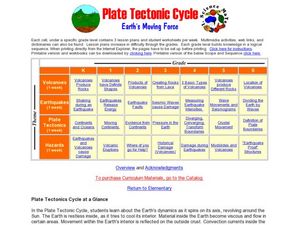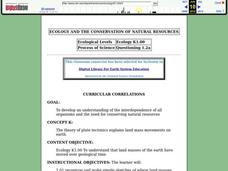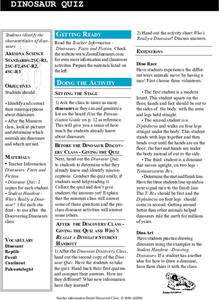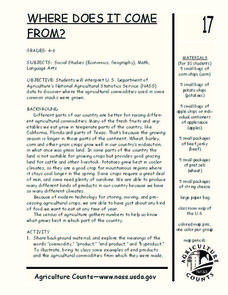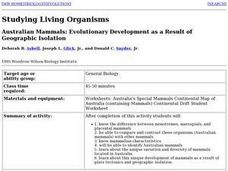Curated OER
Rolling Around the Continents
Learners practice throwing skills by rolling a ball at a target, and practice the location of the seven continents, the equator, and the northern and southern hemispheres.
Curated OER
Continent Adventure
Students review or learn information regarding the 7 continents on our planet. It is also a fun movement and fitness activity.
Curated OER
Name That Continent
Learners practice locating the seven continents, four hemispheres, and four oceans using a large world map and a review song. They also import a world map to the Kid Pix computer program then type in proper labels on the map. There are...
Curated OER
Go for the Gold!
Young athletes practice various locomotor movements. They use locomotor skills as directed by the teacher to move between "Olympic rings" (hula hoops). Students participate in a discussion about Olympic events prior to playing the game.
Education Center
Penguin Puzzlers
Test your pupils' ability with analogies with a cute worksheet featuring penguins. Learners complete each penguin-related analogy by circling the best choice to complete each one. They then take the letters they circled and move them...
Curated OER
The Columbian Exchange
Take a closer look at what was traded between the Europeans and the Americas during the Columbian Exchange and which led to important cultural and economic developments in both regions. Tip: Expand the assignment to include animals,...
Curated OER
Plate Tectonic Cycle
Learners explore the Earth's movements by completing worksheets. In this plate tectonics instructional activity, students define such natural disasters as volcanoes, earthquakes, tsunamis and mudslides and discuss their connections to...
Curated OER
Ecology And the Conservation of Natural Resources
Students study Alfred Wegener's theory of continental drift and how the continents were connected in one large land mass called Pangaea. They examine plate tectonics and the theory that the earth's surface is composed of large moving...
K12 Reader
From Nomad to Farmer
The gradual evolution of the earliest settlers in North America from nomads to farmers is the subject of a reading comprehension worksheet that asks kids to answer a series of questions using information provided in the reading passage.
National Endowment for the Humanities
How to Win a World War
High schoolers are have begun to learn the art of diplomacy with each other, but do they understand how diplomacy works at a global level? The second in a series of four lessons, guides scholars in evaluating primary sources. The why...
Desert Discoveries
Dinosaur Quiz
Young scientists explore the world of dinosaurs. They engage in a variety of activities designed to help correct misconceptions about dinosaurs, and which help them to determine which animals are dinosaurs and which are not. There is a...
Curated OER
Lizard Lab
In this detailed and comprehensive multi-day activity, budding evolutionary biologists use real data from lizard populations in the Canary Islands to examine evolution and natural selection.
Humanities Texas
Primary Source Worksheet: Lyndon B. Johnson, Excerpt from “The Great Society”
Young historians examine Lyndon Johnson's vision for a rich, powerful, and upward society as detailed in this excerpt from his famous "Great Society" speech presented at the University of Michigan in 1964.
K12 Reader
Coyote: The Survivor of North America
Coyotes in Chicago? Yip. Middle schoolers demonstrate their ability to identify details that support the idea that coyotes are adaptable creatures.
North Iowa
Identifying Kinds of Pronouns
Provide your ESL or ELA pupils with some skills practice for identifying various kinds of pronouns. Comprised of 40 problems and broken into four parts, pupils first underline all the pronouns in each sentence, then identify them as...
Curated OER
Where Does It Come from?
Students read articles about various agricultural products and create a map using the statistics in the article. In this agricultural statistics lesson, students look at the geography of the country and which products come from the...
Curated OER
Atlatl (Native Americans)
Learners discover what an atlatl is and how to use it. In this Native American lesson, students discuss the history of the Native American atlatl and practice throwing with it. Learners will analyze the effects of the atlatl in terms of...
Curated OER
Walking on Maps
Pupils are introduced to the various types of maps and their functions. As a class, they play a game similar to twister to review map concepts. They answer questions about the map and use the internet to view larger maps of the world.
Curated OER
Australian Mammals: Evolultionary Development as a Result of Geographic Isolation
Students examine the differences between monotremes, marsupials, and placental mammals and are able to contrast these organisms with other mammals. They learn about unique variation and the diversity of mammals located in Australia.
Curated OER
Shake, Rattle and Erupt
Young scholars study myths regarding four earthquakes myths. They receive a list of supplies each family should have at home to prepare for an earthquake and construct an "Earthquake Preparation" poster showing some of the most important...








